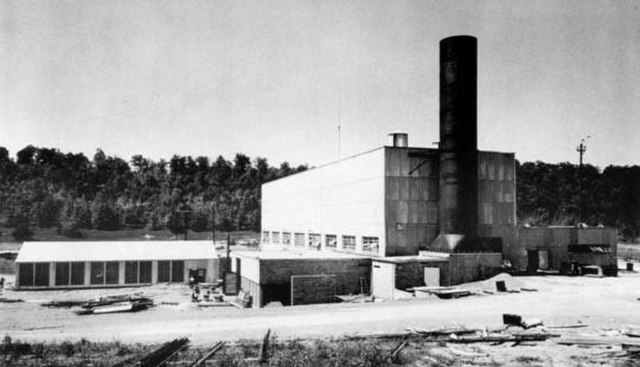Aircraft Nuclear Propulsion
The Aircraft Nuclear Propulsion (ANP) program and the preceding Nuclear Energy for the Propulsion of Aircraft (NEPA) project worked to develop a nuclear propulsion system for aircraft. The United States Army Air Forces initiated Project NEPA on May 28, 1946. NEPA operated until May 1951, when the project was transferred to the joint Atomic Energy Commission (AEC)/USAF ANP. The USAF pursued two different systems for nuclear-powered jet engines, the Direct Air Cycle concept, which was developed by General Electric, and Indirect Air Cycle, which was assigned to Pratt & Whitney. The program was intended to develop and test the Convair X-6, but was canceled in 1961 before that aircraft was built. The total cost of the program from 1946 to 1961 was about $1 billion.
HTRE-2, left, and HTRE-3, right, on display at the Experimental Breeder Reactor I facility
Aircraft Reactor Experiment building at Oak Ridge National Laboratory
The NB-36H in a test flight, shadowed by a Boeing B-50 Superfortress
HTRE-3.
A nuclear-powered aircraft is a concept for an aircraft intended to be powered by nuclear energy. The intention was to produce a jet engine that would heat compressed air with heat from fission, instead of heat from burning fuel. During the Cold War, the United States and Soviet Union researched nuclear-powered bomber aircraft, the greater endurance of which could enhance nuclear deterrence, but neither country created any such operational aircraft.
The only US aircraft to carry a nuclear reactor was the NB-36H. The reactor was never actually connected to the engines. The program was canceled in 1958.
Experimental HTRE reactors for nuclear aircraft, (HTRE-2 left and HTRE-3 right) on display at the Experimental Breeder Reactor I facility (43°30′42.22″N 113°0′18″W / 43.5117278°N 113.00500°W / 43.5117278; -113.00500).




